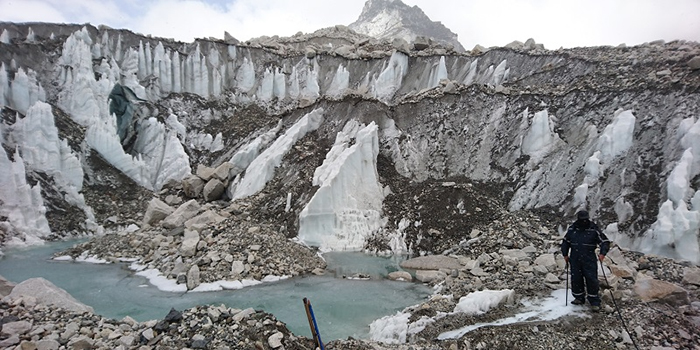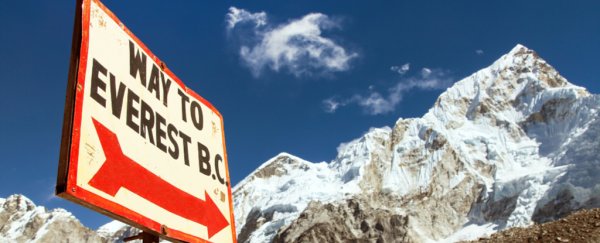Experts have warned that ice in the world's highest glacier – packed around the slopes of Mount Everest – is warmer than it should be, which means it's especially vulnerable to the future effects of climate change.
Measurements recorded deep below the surface layer showed a minimum ice temperature of just −3.3 degrees Celsius (26.06 degrees Fahrenheit).
That's pretty chilly. But what's odd is that these measurements show that the coldest ice on the glacier is actually 2 degrees Celsius (3.6 degrees Fahrenheit) warmer than the mean annual air temperature.
That means it will take very little warming for the ice to start melting.
Not only does this have implications for Everest and similar mountains, it's also going to affect the people living downstream – the huge amount of glacial ice trapped up here is a valuable supply of drinking water for settlements lower down in the valleys.
 (Evan Miles)
(Evan Miles)
"The temperature range we measured from drill sites across the Khumbu Glacier was warmer than we expected – and hoped – to find," says lead researcher Duncan Quincey, from the University of Leeds in the UK.
"Warm ice is particularly vulnerable to climate change because even small increases in temperature can trigger melting."
Using a modified jet washer to bore holes in the ice with hot water, the EverDrill research team took readings as far as 155 metres (509 feet) below the surface, at heights of up to 5,200 metres (17,060 feet) on the Khumbu Glacier.
Temperature sensors were then used to take readings over several months in 2017 and 2018. Geothermal heating, warmer air from lower elevations, and meltwater flow could be responsible for the relatively high temperatures, the researchers say.
"Internal temperature has a significant impact on the complex dynamics of a glacier, including how it flows, how water drains through it and the volume of meltwater runoff – which makes up a crucial part of the water supply for millions of people in the Hindu Kush-Himalaya region," says Quincey.
In fact there's so much ice here – more than anywhere on Earth except the Arctic and Antarctica – that the Hindu-Kush Himalaya region is sometimes referred to as the third pole. An estimated 60 million people rely on water from this region.
The next step for the EverDrill project and other researchers is to work out how typical the temperatures recorded at these three borehole sites are in terms of the glacier and the mountain range as a whole.
Warmer temperatures within the ice mean slight increases in overall temperatures can trigger extensive melting.
Some of the same scientists have also been investigating increased lake formation on the glaciers around Mount Everest. As water absorbs heat better than ice, it creates a positive feedback loop that melts ice around it.
In other words, even slight temperature increases could lead to a significant amount of glacier loss and increased meltwater runoff around Mount Everest.
That's important to factor in as countries across the world try and put a lid on the amount of greenhouse gases our activities are pumping out into the atmosphere.
"The prevalence of temperate and warming ice at high elevations, even beneath thick supraglacial debris, indicates that these glaciers are highly vulnerable to 21st century climate warming," conclude the researchers.
The research has been published in Scientific Reports.
